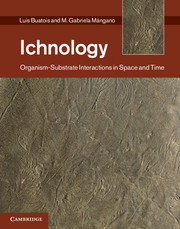5 - The ichnofabric approach
from Part I - Conceptual tools and methods
Published online by Cambridge University Press: 25 October 2011
Summary
I confess frankly, it was the warning voice of David Hume that first, years ago, roused me from dogmatic slumbers, and gave a new direction to my investigations in the field of speculative philosophy.
Immanuel Kant Critique of Pure Reason (1781)We now come to the more immediate subject of this volume, namely the amount of earth which is brought up by worms from beneath the surface.
Charles DarwinThe Formation of Vegetable Mould Through the Action of Worms with Observations on their Habits (1881)
The ichnofabric approach represents a relatively new trend in ichnology that started in the second half of the eighties, becoming much more popular since the nineties. As is the case of the ichnofacies model, the ichnofabric approach has been frequently misunderstood. Earlier studies involving ichnofabrics put too much emphasis on assessing bioturbation and other more significant aspects, such as tiering or evaluation of successive bioturbation events, were commonly overlooked. Even worse, the idea that measuring the intensity of bioturbation could replace trace-fossil identification as ground data for paleoenvironmental interpretations persisted for some years. At present, the idea that ichnofabric analysis is simply measuring the degree of bioturbation has been mercifully abandoned by all serious workers. If the ichnofabric approach is understood as a comprehensive way of analyzing bioturbated deposits, then the wealth of information that may be obtained is huge and not only restricted to paleoenvironmental reconstructions but also of significant potential in understanding reservoir properties, benthic paleoecology, and evolutionary paleoecology. German philosopher Immanuel Kant expressed that his reading of his British peer David Hume roused him from his dogmatic slumber and led him to become a “critical philosopher”. In the same vein, the focus of this chapter, the ichnofabric approach, with its emphasis on taphonomic aspects, helps us to avoid taking the trace-fossil record at face value, permeating the whole interpretative process with some healthy criticism. We will start by providing the basics of the tiering concept before moving into a review of the ichnofabric concept, including aspects of quantifying the degree of bioturbation, visual strategies to present ichnofabric data, the paramount role of taphonomy, and the different types of ichnofabrics. Then, we will present the concept of ichnoguild, which, in our view, is central to the ichnofabric approach. Later, we will briefly review recent developments in the field of paleosol ichnofabrics. We will then address the general role of bioturbation, bioerosion, and biodeposition, before moving to the issue of bioturbation-enhanced permeability and reservoir characterization, a recently developed topic, which is having a strong impact in the petroleum industry. Finally, we will compare the ichnofacies and ichnofabric approaches.
- Type
- Chapter
- Information
- IchnologyOrganism-Substrate Interactions in Space and Time, pp. 83 - 96Publisher: Cambridge University PressPrint publication year: 2011



